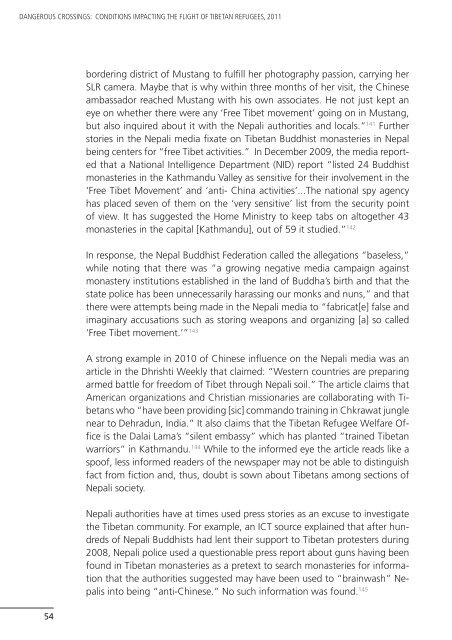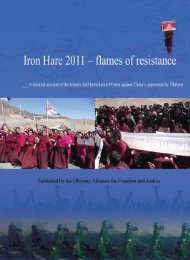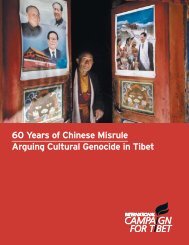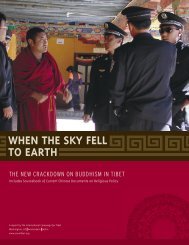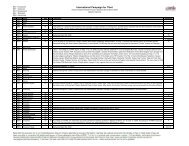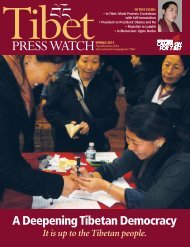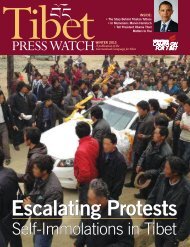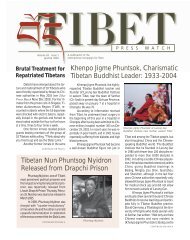DANGEROUS CROSSING: - International Campaign for Tibet
DANGEROUS CROSSING: - International Campaign for Tibet
DANGEROUS CROSSING: - International Campaign for Tibet
Create successful ePaper yourself
Turn your PDF publications into a flip-book with our unique Google optimized e-Paper software.
<strong>DANGEROUS</strong> <strong>CROSSING</strong>S: CONDITIONS IMPACTING THE FLIGHT OF TIBETAN REFUGEES, 2011<br />
54<br />
bordering district of Mustang to fulfill her photography passion, carrying her<br />
SLR camera. Maybe that is why within three months of her visit, the Chinese<br />
ambassador reached Mustang with his own associates. He not just kept an<br />
eye on whether there were any ‘Free <strong>Tibet</strong> movement’ going on in Mustang,<br />
but also inquired about it with the Nepali authorities and locals.” 141 Further<br />
stories in the Nepali media fixate on <strong>Tibet</strong>an Buddhist monasteries in Nepal<br />
being centers <strong>for</strong> “free <strong>Tibet</strong> activities.” In December 2009, the media reported<br />
that a National Intelligence Department (NID) report “listed 24 Buddhist<br />
monasteries in the Kathmandu Valley as sensitive <strong>for</strong> their involvement in the<br />
‘Free <strong>Tibet</strong> Movement’ and ‘anti- China activities’...The national spy agency<br />
has placed seven of them on the ‘very sensitive’ list from the security point<br />
of view. It has suggested the Home Ministry to keep tabs on altogether 43<br />
monasteries in the capital [Kathmandu], out of 59 it studied.” 142<br />
In response, the Nepal Buddhist Federation called the allegations “baseless,”<br />
while noting that there was “a growing negative media campaign against<br />
monastery institutions established in the land of Buddha’s birth and that the<br />
state police has been unnecessarily harassing our monks and nuns,” and that<br />
there were attempts being made in the Nepali media to “fabricat[e] false and<br />
imaginary accusations such as storing weapons and organizing [a] so called<br />
‘Free <strong>Tibet</strong> movement.’” 143<br />
A strong example in 2010 of Chinese influence on the Nepali media was an<br />
article in the Dhrishti Weekly that claimed: “Western countries are preparing<br />
armed battle <strong>for</strong> freedom of <strong>Tibet</strong> through Nepali soil.” The article claims that<br />
American organizations and Christian missionaries are collaborating with <strong>Tibet</strong>ans<br />
who “have been providing [sic] commando training in Chkrawat jungle<br />
near to Dehradun, India.” It also claims that the <strong>Tibet</strong>an Refugee Welfare Office<br />
is the Dalai Lama’s “silent embassy” which has planted “trained <strong>Tibet</strong>an<br />
warriors” in Kathmandu. 144 While to the in<strong>for</strong>med eye the article reads like a<br />
spoof, less in<strong>for</strong>med readers of the newspaper may not be able to distinguish<br />
fact from fiction and, thus, doubt is sown about <strong>Tibet</strong>ans among sections of<br />
Nepali society.<br />
Nepali authorities have at times used press stories as an excuse to investigate<br />
the <strong>Tibet</strong>an community. For example, an ICT source explained that after hundreds<br />
of Nepali Buddhists had lent their support to <strong>Tibet</strong>an protesters during<br />
2008, Nepali police used a questionable press report about guns having been<br />
found in <strong>Tibet</strong>an monasteries as a pretext to search monasteries <strong>for</strong> in<strong>for</strong>mation<br />
that the authorities suggested may have been used to “brainwash” Nepalis<br />
into being “anti-Chinese.” No such in<strong>for</strong>mation was found. 145


